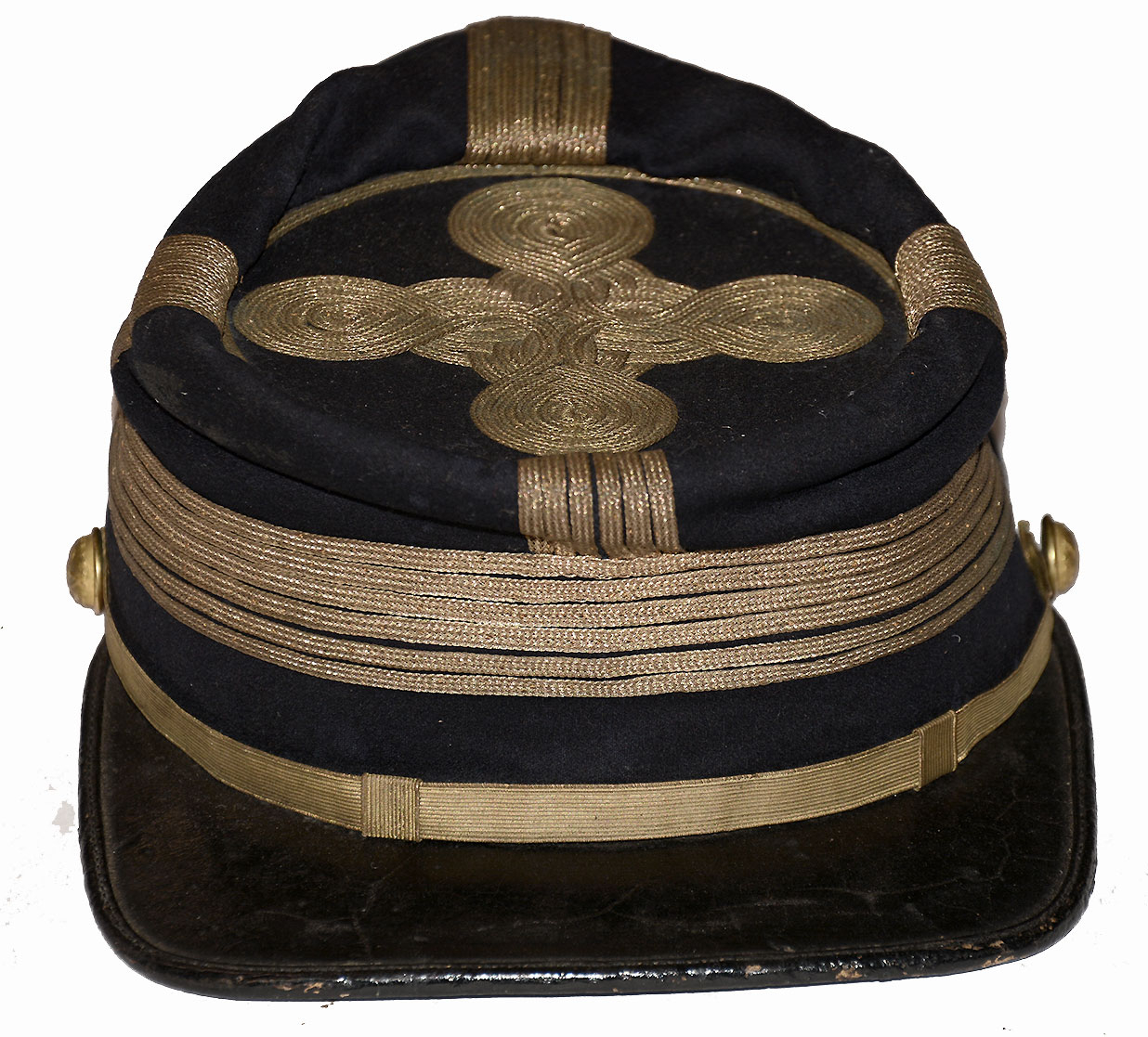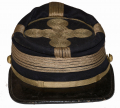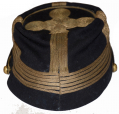site search
online catalog
BEAUTIFUL TIFFANY-MADE GENERAL OFFICER’S CAP OF GEN. JOHN HENRY HOBART WARD: DEFENDED THE LEFT OF THE UNION LINE IN HARD FIGHTING AT GETTYSBURG ON JULY 2; “THAT GALLANT OFFICER” – JOE HOOKER; “ONE OF THE BRAVEST OF THE BRAVE” – PHIL KEARNEY

$30,000.00 SOLD
Quantity Available: None
Item Code: 1179-339
This historic Tiffany-made general officer’s cap belonged to Brigadier General John Henry Hobart Ward, an impressive and remarkable figure whose brigade held the left flank of Sickles’s advanced line here at Gettysburg on July 2 and blunted the opening attacks of Hood’s division in fierce fighting in the area of Devil’s Den and Houck’s Ridge below Little Round Top. The cap was published in Troiani’s Uniforms and Regiments of the Civil War and comes to us from the collections of the Texas Civil War Museum. It is accompanied by a 1998 letter from Les Jensen, West Point military historian, curator of arms and armor, and Civil War textile expert, analyzing the cap, which he says, “is probably one of the finest Union General’s kepis in existence in terms of condition and rarity,” and notes that Ward’s extant Tiffany-made presentation sword bears his battle honors up to but not including Gettysburg, suggesting the cap, like the sword, was acquired prior to the battle. Ward amassed an impressive combat record, commendations for gallantry, several wounds, and some controversy during his service as an enlisted man in the Mexican War and his Civil War regimental, brigade, and occasional division commands in the Civil War in battles from First Bull Run in 1861 to Grant’s 1864 Overland Campaign. Given Ward’s role here at the Battle of Gettysburg, we are especially proud to offer it.
The cap is finely tailored, a kepi in style (having an inset crown with a “roll-over” onto the crown of the sides at the top) and made of dark blue wool, measuring 3-inches in front, 6-inches at rear, with the crown having 5-inch exterior diameter. The lower perimeter of the cap is unadorned, creating a 1-inch wide blue band. Above this band the cap is circled by six strands of 3/16-inch gold braid, placed close together, with the same number up the sides, top and back, extending over top roll of the sides. A single strand runs around the perimeter of the crown next the roll, and four strands form a tight quatrefoil in the center of the top. The chinstrap is 3/8-inch gold braid, with false loops, secured by General Staff buttons. The visor is patent leather with bound edge and green underside.
On the interior, the impressed, brown imitation Morocco sweatband is 1-½ inches tall, complete, intact, and in place, though the stitching along the lower edge has come lose around the front and forward sides. Behind it the cap has a stiffener to maintain its shape running around the base of the cap, about 2-1/4 inches tall at the back and 2-1/2 inches at the front. This is concealed by the rose-colored lining of the sides that comes down behind the sweatband and has a drawstring top opening in a circle to show a similarly colored lining on the underside of the top to which is sewn a lavender cloth label embossed in gilt lettering: “TIFFANY & CO / 550 & 552 Broadway / New York.” This is their Civil War address and we show a November 1861 advertisement by the firm, who are well known to Civil War collectors, selling weapons and a large variety of high-quality military goods privately and on contract. They left the general military goods business after the war, though still dealt in banners, badges and pistols, and did work on special order. (See Bazelon Vols. 1 and 2, for details on the military dealings of the firm.) Jensen mentions his Tiffany sword, and know of other Ward artifacts as well, including his general’s frock coat, a dress hat, and in the NPS collection at Gettysburg, his boots, spurs, sash, and belt, along with his revolver and holster.
Born in New York City in 1823, the son and grandson of veterans who reportedly died from the longterm effects of wartime wounds, Ward received a good deal of praise for his combat performance in the Civil War, along with his own wounds both the Civil War and earlier in Mexico. He enlisted in the army on April 13, 1842, at age 19 according to the enlistment records where he is recorded as a clerk by profession, and rose from private in Company B, 7th US Infantry to regimental Sergeant Major, seeing action at Fort Brown, Monterrey (where he was first wounded,) Cerro Gordo, and Humantla. He was a large man, standing 5’11” and was later said, true or not, to have been pugilist, perhaps accounting for his ability to exercise the authority necessary in a Sergeant Major. He was discharged at the expiration of his term of service in April 1847 at Plan Del Rio, Mexico. Some sources say he remained in service to 1851, but all agree he married a girl from Vera Cruz, and was back in New York by 1851 when he became state Assistant Commissary General, rising to Commissary General in 1855, and retiring in 1859.
Thus, with both combat and administrative experience, and likely some political connections, he helped organize two regiments of New York volunteers when the Civil War began and at age 37 enrolled again May 25, 1861, and was commissioned Colonel of the 38th New York Infantry, a two-year regiment, as of May 30. He commanded the regiment at First Bull Run as part of Wilcox’s brigade in the fighting at Henry House Hill, during which he took command of the brigade after the wounding of Wilcox, who praised in him in the official report. In the Peninsular Campaign he led the regiment at Yorktown, Williamsburg (where Kearney praised him in his official report,) and Fair Oaks, where he temporarily took over brigade command from Birney, and gained additional praise from Hooker. The regiment saw subsequent action at Jordan’s Ford, Glendale, and Malvern Hill in the Seven Days Battles, and then in Pope’s Virginia Campaign at Second Bull Run and Chantilly, where Kearney’s death moved him up to temporary command of the brigade (2nd Brig, 1st Div, 3rd Corps) from Sept. 1 to Sept 13, and to its permanent command after he was commissioned Brigadier General, U.S. Volunteers as of October 4, 1862, with letters of support from Hooker, Heintzelman, Kearney, and Birney.
He mustered out of the 38th NY to accept the promotion on October 10, 1862, officially taking over command of the brigade from Birney on October 30, and in December led the brigade in attacks on left at Fredericksburg, losing 629 men in the fruitless assault, and another 248 casualties, from both enemy and friendly fire, in a foolish night attack ordered by Sickles at Chancellorsville in May 1863 that resulted in the mounted Ward reportedly trampling two of his own men in the chaos.
Sickles’s poor military judgment placed Ward and his men in another difficult spot at Gettysburg with the unauthorized advance of the 3rd Corps to the Peach Orchard on July 2. Assigned to hold the left of Sickles’s attenuated lines, Ward’s men were the first to be struck by Longstreet’s progressive assaults “en echelon,” repulsing initial attacks and fighting elements of Law’s, Robertson’s and Benning’s brigades before being forced back with the loss of 781 out of 2,186 engaged. Ward was elevated to temporary division command as Birney took over the corps from the wounded Sickles, and reportedly suffered a minor wound in the fighting. He retained command of the division at Wapping Heights and later in the year at Kelly’s Ford, with his brigade’s Gettysburg marker maintaining he was also wounded at those engagements. He accumulated other letters of recommendation for promotion to Major General and division command during the period, but was back in command of the brigade for the Mine Run Campaign, and remained at that post after its integration into the 2nd Corps in March, from which it emerged as a reorganized 1st Brigade, 2nd Division, 2nd Army Corps, expanded to nine regiments, for Grant’s Overland Campaign.
Ward’s military career ended after the battles of Wilderness and Spottsylvania for reasons never officially published and still debated. At Wilderness on May 6, a Confederate attack drove back parts of his brigade and he was accused of mounting an artillery caisson and racing to the rear, with detractors asserting he led the panicked retreat and supporters maintaining he was getting ahead of it to rally his men. He failed to get an audience with Hancock, but four days later was still in command of the brigade when it joined the 5th Corps assault at Laurel Hill. He was wounded in the temple by a shell fragment at the start of the fighting, but apparently took part in the assault, which failed of coordination with Emory Upton’s attack on the Salient to left, but like Upton, gained a temporary lodgment in the Confederate works.
The fighting was bloody and the attack, like Upton’s, was defeated in the judgment of some more by the lack of support than anything else, but Ward likely felt he had something to prove in the grand assault of May 12. Positioned on the left of Birney’s line, Ward charged on Barlow’s right. The attack succeeded in breaking open the tip of the Salient, with Ward’s troops getting over the Confederate works and into the same hand-to-hand and bloody close-in fighting that lasted throughout the day. Birney reported encountering Ward running rearward and looking for his horse, which sounded like an excuse. Hancock, on the other hand, thought him too aggressive: “he was being reckless and insisted upon making a charge upon the enemy’s works along the parapet.” Both, however, seemed to agree that he was out of control and likely intoxicated. Birney ordered him under arrest and to the rear.
Ward protested that reports of misbehavior at Wilderness were false and propagated by staff officers hostile to him. Newspapers reported that his Wilderness rallying cry of, “Remember the old Third Corps!” alienated his Second Corps superiors, also that there was a plot to have him peremptorily cashiered that was thwarted by announcement of a court-martial or that Ward had requested a court of inquiry, both of which simply vanished, with the whole mess buried by simply announcing Ward’s honorable muster out of service on July 18, which caught him by surprise.
Ward returned to civilian life in New York, engaging in some political work for McClellan, serving as a Trustee for the National Petroleum Company, and reportedly some city jobs before gaining appointment as a clerk in the Superior Court in 1871 and in 1896 as clerk in the state Supreme Court, a post he still held in the summer of 1903 when he was struck and killed by a train while on vacation in Monroe, NY. Efforts to gain him a brevet to Major General in 1867 for “gallant and meritorious” wartime service came to naught, but no scandal and only his many commendations were cited in his obituaries, along with his continued soldierly bearing even in his late years: “his appearance, with long white mustache and broad shoulders, frequently attracted the attention of spectators in the State Courts Building.” Given the number of severe battles he was in and his several wounds, something of a family trait, his muster out in 1864 had likely prolonged his life.
Ward was an impressive figure with a remarkable record. His cap is a great combination of eye-appeal and history. [sr] [ph:L]
~~~~~~~~~~~~~~~~~~~~~~~~~~~~~~~~~~~
THIS ITEM, AS WITH ALL OTHER ITEMS AVAILABLE ON OUR WEB SITE,
MAY BE PURCHASED THROUGH OUR LAYAWAY PROGRAM.
CLICK HERE FOR OUR POLICIES AND TERMS.
THANK YOU!
Inquire About BEAUTIFUL TIFFANY-MADE GENERAL OFFICER’S CAP OF GEN. JOHN HENRY HOBART WARD: DEFENDED THE LEFT OF THE UNION LINE IN HARD FIGHTING AT GETTYSBURG ON JULY 2; “THAT GALLANT OFFICER” – JOE HOOKER; “ONE OF THE BRAVEST OF THE BRAVE” – PHIL KEARNEY
For inquiries, please email us at [email protected]
Most Popular
Historical Firearms Stolen From The National Civil War Museum In Harrisburg, Pa »
Theft From Gravesite Of Gen. John Reynolds »
Cavalry Carbine Sling Swivel »
Fine Condition Brass Infantry Bugle Insignia »
featured item
BUGLER’S SHELL JACKET IDENTIFIED TO PRIVATE WILLIAM BOPP, 2ND MISSOURI STATE MILITIA CAVALRY
Scarce Union Missouri cavalryman's jacket modified with Zouave style V-neck collar and custom-trimmed with bright yellow narrow cording at cuffs and on front, forming a semi-regulation rack pattern with looped cloverleaf ends. Seven-button front with… (591-04). Learn More »
















